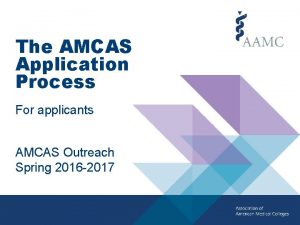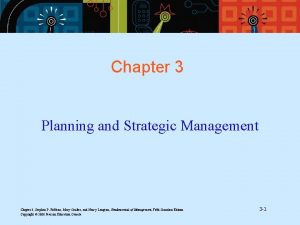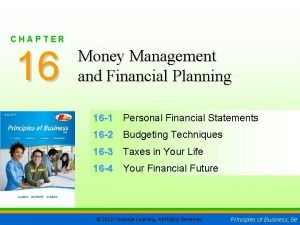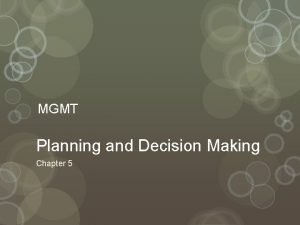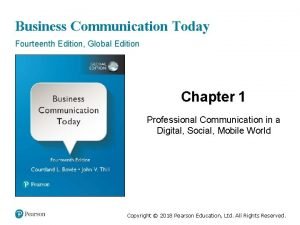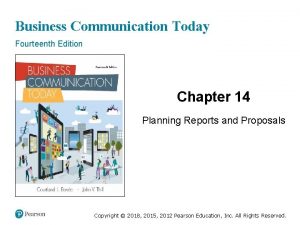Management Fourteenth Edition Chapter 8 Planning Work Activities

























- Slides: 25

Management Fourteenth Edition Chapter 8 Planning Work Activities Copyright © 2018, 2016, 2014 Pearson Education, Inc. All Rights Reserved

Learning Objectives 8. 1 Define the nature and purposes of planning. 8. 2 Classify the types of goals organizations might have and the plans they use. 8. 3 Compare and contrast approaches to goal-setting and planning. Know how to set goals personally and create a useful, functional to-do list Develop your skill at helping your employees set goals 8. 4 Discuss contemporary issues in planning. Copyright © 2018, 2016, 2014 Pearson Education, Inc. All Rights Reserved

What is Planning? • Planning: management function that involves setting goals, establishing strategies for achieving those goals, and developing plans to integrate and coordinate work activities • Formal planning – Specific, time-oriented goals – Goals written and shared Copyright © 2018, 2016, 2014 Pearson Education, Inc. All Rights Reserved

Why Do Managers Plan? • Provides direction • Reduces uncertainty • Minimizes waste and redundancy • Establishes the goals and standards for controlling Copyright © 2018, 2016, 2014 Pearson Education, Inc. All Rights Reserved

Goals and Plans • Goals (objectives): desired outcomes or targets • Plans: documents that outline how goals are going to be met Copyright © 2018, 2016, 2014 Pearson Education, Inc. All Rights Reserved

Types of Goals • Financial goals • Strategic goals • Stated goals: official statements of what an organization says, and what it wants its various stakeholders to believe, its goals are. Nike’s goal is “delivering inspiration and innovation to every athlete. ” • Real goals: goals that an organization actually pursues, as defined by the actions of its members Copyright © 2018, 2016, 2014 Pearson Education, Inc. All Rights Reserved

Exhibit 8 -1 Types of Plans Exhibit 8 -1 shows the most popular ways to describe organizational plans. Copyright © 2018, 2016, 2014 Pearson Education, Inc. All Rights Reserved

Strategic and Operational Plans • Strategic plans: plans that apply to the entire organization and establish the organization’s overall goals • Operational plans: plans that encompass a particular operational area of the organization Copyright © 2018, 2016, 2014 Pearson Education, Inc. All Rights Reserved

Long-term and Short-term Plans • Long-term plans: plans with a time frame beyond three years • Short-term plans: plans covering one year or less Copyright © 2018, 2016, 2014 Pearson Education, Inc. All Rights Reserved

Specific and Directional Plans • Specific plans: plans that are clearly defined and leave no room for interpretation • Directional plans: plans that are flexible and set out general guidelines Copyright © 2018, 2016, 2014 Pearson Education, Inc. All Rights Reserved

Single-use and Standing Plans • Single-use plans: a one-time plan specifically designed to meet the needs of a unique situation • Standing plans: ongoing plans that provide guidance for activities performed repeatedly Copyright © 2018, 2016, 2014 Pearson Education, Inc. All Rights Reserved

Approaches to Setting Goals • Traditional goal-setting: an approach to setting goals in which top managers set goals that then flow down through the organization and become subgoals for each organizational area Copyright © 2018, 2016, 2014 Pearson Education, Inc. All Rights Reserved

Exhibit 8 -2 The Downside of Traditional Goal-Setting Exhibit 8 -2 illustrates what can happen as the goals make their way down from the top of the organization to lower levels. Copyright © 2018, 2016, 2014 Pearson Education, Inc. All Rights Reserved

Means-Ends Chain and MBO • Means-ends chain: an integrated network of goals in which the accomplishment of goals at one level serves as the means for achieving the goals, or ends, at the next level • Management by objectives (MBO): a process of setting mutually agreed upon goals and using those goals to evaluate employee performance Copyright © 2018, 2016, 2014 Pearson Education, Inc. All Rights Reserved

Steps in Goal-Setting 1. Review the organization’s mission, or purpose. 2. Evaluate available resources. 3. Determine the goals individually or with input from others. 4. Write down the goals and communicate them to all who need to know. 5. Review results and whether goals are being met. Copyright © 2018, 2016, 2014 Pearson Education, Inc. All Rights Reserved

Developing Plans • Contingency factors in planning: – Organizational level – Degree of environmental uncertainty – Length of future commitments Copyright © 2018, 2016, 2014 Pearson Education, Inc. All Rights Reserved

Exhibit 8 -5 Planning and Organizational Level Exhibit 8 -5 shows the relationship between a manager’s level in the organization and the type of planning done. Copyright © 2018, 2016, 2014 Pearson Education, Inc. All Rights Reserved

Environmental Uncertainty • When uncertainty is high, plans should be specific, but flexible. Copyright © 2018, 2016, 2014 Pearson Education, Inc. All Rights Reserved

Length of Future Commitments • Commitment concept: plans should extend far enough to meet those commitments made when the plans were developed Copyright © 2018, 2016, 2014 Pearson Education, Inc. All Rights Reserved

Approaches to Planning • Formal planning department: a group of planning specialists whose sole responsibility is helping to write organizational plans Copyright © 2018, 2016, 2014 Pearson Education, Inc. All Rights Reserved

How Can Managers Plan Effectively in Dynamic Environments? • Develop plans that are specific but flexible • Keep planning even when the environment is uncertain • Allow lower organizational levels to set goals and develop plans Copyright © 2018, 2016, 2014 Pearson Education, Inc. All Rights Reserved

How Can Managers Use Environmental Scanning? • Environmental scanning: screening information to detect emerging trends • Competitor intelligence: gathering information about competitors that allows managers to anticipate competitors’ actions rather than merely react to them Copyright © 2018, 2016, 2014 Pearson Education, Inc. All Rights Reserved

Digital Tools • Business intelligence: data that managers can use to make more effective strategic decisions • Digital tools: technology, systems, or software that allow the user to collect, visualize, understand, or analyze data Copyright © 2018, 2016, 2014 Pearson Education, Inc. All Rights Reserved

Three Prevalent Digital Tools • Data visualization tools • Cloud computing: refers to storing and accessing data on the Internet rather than on a computer’s hard drive or a company’s network • Internet of things (Io. T): allows everyday “things” to generate and store and share data across the Internet Copyright © 2018, 2016, 2014 Pearson Education, Inc. All Rights Reserved

Copyright © 2018, 2016, 2014 Pearson Education, Inc. All Rights Reserved
 Management fourteenth edition
Management fourteenth edition Fourteenth amendment
Fourteenth amendment How to write a summer poem
How to write a summer poem Social work: an empowering profession 9th edition chapter 1
Social work: an empowering profession 9th edition chapter 1 Using mis (10th edition) 10th edition
Using mis (10th edition) 10th edition Mis
Mis The statement of cash flows helps users
The statement of cash flows helps users Which of these sports are indoor outdoor
Which of these sports are indoor outdoor Primary and support activities
Primary and support activities Tertiary activities definition
Tertiary activities definition Principles of management by stephen p robbins
Principles of management by stephen p robbins Chapter 4 work and energy section 1 work and machines
Chapter 4 work and energy section 1 work and machines Daily work activities
Daily work activities How did you carry out extension work activities?
How did you carry out extension work activities? Work, power and energy activities
Work, power and energy activities Work immersion meaning
Work immersion meaning Amcas verification
Amcas verification Aamc application timeline
Aamc application timeline Organize and complete daily work activities doc
Organize and complete daily work activities doc Work preparation activities
Work preparation activities Management chapter 5 planning and decision making
Management chapter 5 planning and decision making Chapter 3 planning
Chapter 3 planning Chapter 16 money management and financial planning
Chapter 16 money management and financial planning Chapter 16 money management and financial planning
Chapter 16 money management and financial planning Options-based planning
Options-based planning Strategic planning vs tactical planning
Strategic planning vs tactical planning
















